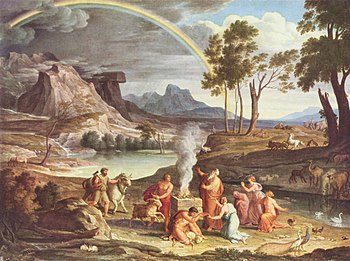
Doubting the Documentary Hypothesis
Back in October of last year I mentioned that I wanted at some point in the future to take a more detailed look at Gary Rendsburg’s audio course on Genesis, with special emphasis on the Documentary Hypothesis (DH). As you recall, Rendsburg doubts many of the claims advanced by DH scholars, especially Julius Wellhausen.
While he would grant the existence of another tradition behind the book of Leviticus (i.e., the Priestly or P source), as well as behind the book of Deuteronomy (i.e., the Deuteronomist, D), Rendsburg rejects the idea of trying to separate sources in the book of Genesis. He prefers to understand the text as a unified whole.
As with many DH-doubters, Rendsburg reserves a special level of skepticism (if not outright disdain) for the notion that two separate sources comprise the story of the Great Flood (Gen. 6-9). In his 2004 article, “The Biblical Flood Story in the Light of the Gilgameš Flood Account” (in the pricey Gilgameš and the World of Assyria), Rendsburg insists that we cannot split the story into the supposed P and J (i.e., Jahwist or Yahwist) sources, because:
If one reads the two stories as separate entities, one will find that elements of a whole story are missing from either the J or the P version. Only when read as a whole does Genesis 6-8 read as a complete story, and — here is the most important point I wish to make — not only as a complete story, but as a narrative paralleling perfectly the Babylonian flood story tradition recorded in Gilgameš Tablet XI, point by point, and in the same order. (Rendsburg, 2004, p. 115)
He finds the very idea worthy of derision.
That is to say, according to the dominant view of biblical scholars, we are supposed to believe that two separate authors wrote two separate accounts of Noah and the flood, and that neither of them included all the elements found in the Gilgameš Epic, but that when the two were interwoven by the redactor, voilà, the story paralleled the Gilgameš flood story point-by-point, feature-by-feature, element-by-element. (Rendsburg, 2004, p. 116, emphasis mine)
Rendsburg unwittingly provides an object lesson in how conservative scholars habitually misunderstand and misrepresent the DH. In this and subsequent posts we’ll look at his thesis, as he put it, point by point.
Two sources: separate and complete?
Prof. Rendsburg makes the common mistake of assuming Wellhausen believed that the flood story in Genesis could be separated into two complete sources. But, in fact, he said no such thing.

